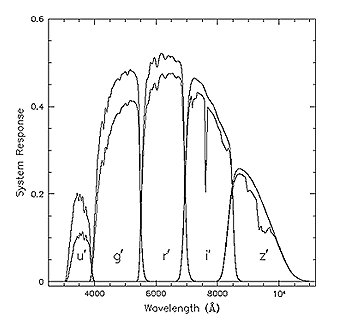Background Information
Filters
A filter is a special piece of glass designed to allow only certain wavelengths of light, or colors, to pass through it. As its name suggests, it filters out unwanted light. For example, the Sloan “green” filter, designated as g’, only allows light with a wavelength between 400 to 550 nm to pass through. All other light will be blocked, so any object emitting light outside of this 400-550 nm range will appear dark. The Sloan “red” filter, or r’, only transmits light with a wavelength between 550–700 nm. You have most likely seen this effect with the blue and red 3-D glasses. If you look at a stop sign through the red lens, it looks bright, but when you look at it through the blue lens, you hardly see anything. Similarly, if we then look at a red star, such as Betelgeuse, through the red (r’) filter, it will appear very bright since the star is very red. However, if we look at Betelgeuse through the green (g’) filter, it will appear much darker. Since Betelgeuse does not emit very much light in the 400-550 nm range, and all the red light will be blocked off, the green filter will produce a dim image of Betelgeuse.

Figure 1: Plot showing the wavelength coverage of the Sloan filters, in angstroms. The y-axis shows the transmission of each filter (e.g., 0.5 means half of the photons that strike the filter are transmitted). The upper curve shows transmission for a filter in a vacuum, and the bottom curve is for a filter looking through Earth's atmosphere.
Note: The names of filters can be misleading. While the green filter certainly does transmit green light, it also transmits blue light and any other color with a wavelength between 400-550 nm. Likewise, the red filter will transmit colors other than red, such as yellow and orange. The name of a filter is just that, a name.